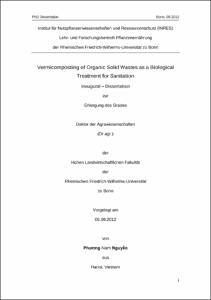Nguyễn, Phương-Nam: Vermicomposting of Organic Solid Wastes as a Biological Treatment for Sanitation. - Bonn, 2012. - Dissertation, Rheinische Friedrich-Wilhelms-Universität Bonn.
Online-Ausgabe in bonndoc: https://nbn-resolving.org/urn:nbn:de:hbz:5n-29727
Online-Ausgabe in bonndoc: https://nbn-resolving.org/urn:nbn:de:hbz:5n-29727
@phdthesis{handle:20.500.11811/5125,
urn: https://nbn-resolving.org/urn:nbn:de:hbz:5n-29727,
author = {{Phương-Nam Nguyễn}},
title = {Vermicomposting of Organic Solid Wastes as a Biological Treatment for Sanitation},
school = {Rheinische Friedrich-Wilhelms-Universität Bonn},
year = 2012,
month = sep,
note = {More than 38 billion m3 of organic solid wastes (OSW) are produced annually from human, livestock and crop activities worldwide. To achieve the Millennium Development Goal for sanitation (MDG7), several alternatives for OSW treatments have been introduced, some of which follow the concept of ecological sanitation (EcoSan). Based on the EcoSan approach, one biological treatment which is now being widely developed, is vermicomposting.
This thesis examines monoculture (Eisenia fetida) and polyculture (Eisenia fetida and Dendrobaena veneta) vermicomposting of three OSW materials, separated solids of digested biogas slurry (Bs), non-urine faecal matter (Fm) and bio-waste (Bw), to produce hygienically safe products.
Preliminary suitability tests of the three fresh materials for vermicomposting showed that E. fetida did not accept these materials, most likely due to unsuitable levels of either high pH (~8.5), EC (~9.0 mS cm-1), or total ammonium nitrogen (TAN) (>10 g kg-1), or low pH (<6.0).
Based on the finding that a small TAN amount (<30 mmol L-1) at alkaline pH (>7.0) dramatically affected the earthworms, the fresh Bs were pre-treated for 2 weeks by composting to eliminate some TAN. With that pre-treatment, the low pH of fresh Bw (<5.0) increased up to 7.5. Consequently, two single pre-treated Bs and Bw were accepted by earthworms for vermicomposting, whereas without pre-treatment, 100% mortality of earthworms was found in single Fm due to increased TAN content (from 25.7 to 526 mmol kg-1) during storage. However, three mixtures of Fm, Bs and Bw (namely BsBw, FmBw and BsFmBw) were accepted and digested by both worm species due to the less toxic influence of TAN (<30 mmol kg-1).
There were no significant differences in physico-chemical properties of all vermicomposted substrates and qualities of products between monoculture and polyculture treatment. After 12 weeks of vermicomposting plus 12 weeks of stabilisation storage for maturing, all 24-week vermicomposts of five OSW materials seemed to be mature (the respiration index for four days (AT4) <10 mg O2 g-1), and met the European Union (EU) threshold for compost maturity.
From positive occurrences in 10.0 g fresh OSW, Salmonella spp. was not found in 10.0 g of the final products. In addition, numbers of Enterococcus spp. and E. coli in vermicomposts were reduced strongly (2.7-5.8 and 3.3-6.4 log10 units, respectively). According to WHO guidelines for sanitation, these products could be applied safely in agriculture.},
url = {https://hdl.handle.net/20.500.11811/5125}
}
urn: https://nbn-resolving.org/urn:nbn:de:hbz:5n-29727,
author = {{Phương-Nam Nguyễn}},
title = {Vermicomposting of Organic Solid Wastes as a Biological Treatment for Sanitation},
school = {Rheinische Friedrich-Wilhelms-Universität Bonn},
year = 2012,
month = sep,
note = {More than 38 billion m3 of organic solid wastes (OSW) are produced annually from human, livestock and crop activities worldwide. To achieve the Millennium Development Goal for sanitation (MDG7), several alternatives for OSW treatments have been introduced, some of which follow the concept of ecological sanitation (EcoSan). Based on the EcoSan approach, one biological treatment which is now being widely developed, is vermicomposting.
This thesis examines monoculture (Eisenia fetida) and polyculture (Eisenia fetida and Dendrobaena veneta) vermicomposting of three OSW materials, separated solids of digested biogas slurry (Bs), non-urine faecal matter (Fm) and bio-waste (Bw), to produce hygienically safe products.
Preliminary suitability tests of the three fresh materials for vermicomposting showed that E. fetida did not accept these materials, most likely due to unsuitable levels of either high pH (~8.5), EC (~9.0 mS cm-1), or total ammonium nitrogen (TAN) (>10 g kg-1), or low pH (<6.0).
Based on the finding that a small TAN amount (<30 mmol L-1) at alkaline pH (>7.0) dramatically affected the earthworms, the fresh Bs were pre-treated for 2 weeks by composting to eliminate some TAN. With that pre-treatment, the low pH of fresh Bw (<5.0) increased up to 7.5. Consequently, two single pre-treated Bs and Bw were accepted by earthworms for vermicomposting, whereas without pre-treatment, 100% mortality of earthworms was found in single Fm due to increased TAN content (from 25.7 to 526 mmol kg-1) during storage. However, three mixtures of Fm, Bs and Bw (namely BsBw, FmBw and BsFmBw) were accepted and digested by both worm species due to the less toxic influence of TAN (<30 mmol kg-1).
There were no significant differences in physico-chemical properties of all vermicomposted substrates and qualities of products between monoculture and polyculture treatment. After 12 weeks of vermicomposting plus 12 weeks of stabilisation storage for maturing, all 24-week vermicomposts of five OSW materials seemed to be mature (the respiration index for four days (AT4) <10 mg O2 g-1), and met the European Union (EU) threshold for compost maturity.
From positive occurrences in 10.0 g fresh OSW, Salmonella spp. was not found in 10.0 g of the final products. In addition, numbers of Enterococcus spp. and E. coli in vermicomposts were reduced strongly (2.7-5.8 and 3.3-6.4 log10 units, respectively). According to WHO guidelines for sanitation, these products could be applied safely in agriculture.},
url = {https://hdl.handle.net/20.500.11811/5125}
}






